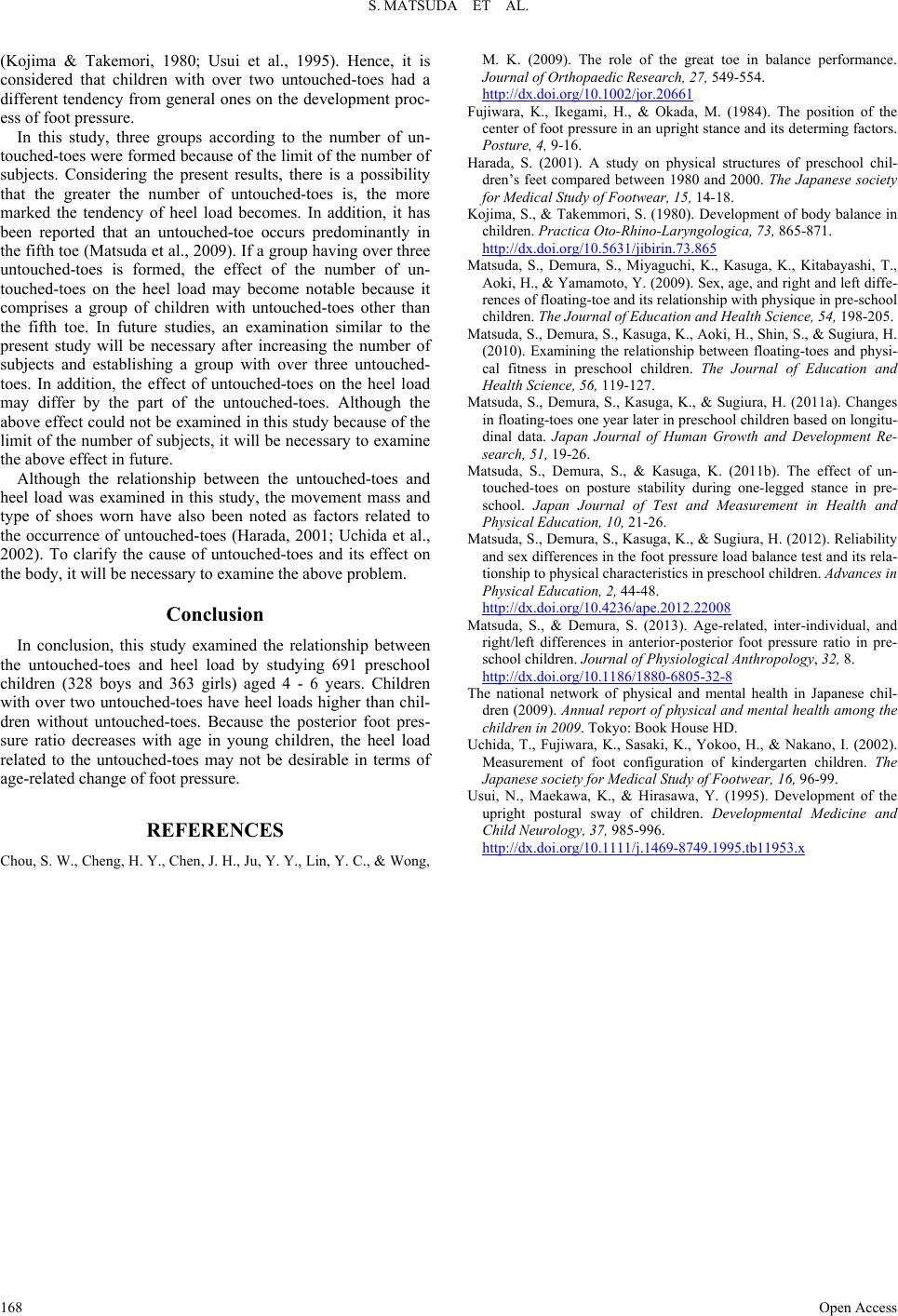
S. MATSUDA ET AL.
(Kojima & Takemori, 1980; Usui et al., 1995). Hence, it is
considered that children with over two untouched-toes had a
different tendency from general ones on the development proc-
ess of foot pressure.
In this study, three groups according to the number of un-
touched-toes were formed because of the limit of the number of
subjects. Considering the present results, there is a possibility
that the greater the number of untouched-toes is, the more
marked the tendency of heel load becomes. In addition, it has
been reported that an untouched-toe occurs predominantly in
the fifth toe (Matsuda et al., 2009). If a group having over three
untouched-toes is formed, the effect of the number of un-
touched-toes on the heel load may become notable because it
comprises a group of children with untouched-toes other than
the fifth toe. In future studies, an examination similar to the
present study will be necessary after increasing the number of
subjects and establishing a group with over three untouched-
toes. In addition, the effect of untouched-toes on the heel load
may differ by the part of the untouched-toes. Although the
above effect could not be examined in this study because of the
limit of the number of subjects, it will be necessary to examine
the above effect in future.
Although the relationship between the untouched-toes and
heel load was examined in this study, the movement mass and
type of shoes worn have also been noted as factors related to
the occurrence of untouched-toes (Harada, 2001; Uchida et al.,
2002). To clarify the cause of untouched-toes and its effect on
the body, it will be necessary to examine the above problem.
Conclusion
In conclusion, this study examined the relationship between
the untouched-toes and heel load by studying 691 preschool
children (328 boys and 363 girls) aged 4 - 6 years. Children
with over two untouched-toes have heel loads higher than chil-
dren without untouched-toes. Because the posterior foot pres-
sure ratio decreases with age in young children, the heel load
related to the untouched-toes may not be desirable in terms of
age-related change of foot pressure.
REFERENCES
Chou, S. W., Cheng, H. Y., Chen, J. H., Ju, Y. Y., Lin, Y. C., & Wong,
M. K. (2009). The role of the great toe in balance performance.
Journal of Orthopaed ic Research, 27, 549-554.
http://dx.doi.org/10.1002/jor.20661
Fujiwara, K., Ikegami, H., & Okada, M. (1984). The position of the
center of foot pressure in an upright stance and its determing factors.
Posture, 4, 9-16.
Harada, S. (2001). A study on physical structures of preschool chil-
dren’s feet compared between 1980 and 2000. The Japanese society
for Medical Study of Footwea r , 15, 14-18.
Kojima, S., & Takemmori, S. (1980). Development of body balance in
children. Practica Oto-Rhino-Laryngologica, 73, 865-871.
http://dx.doi.org/10.5631/jibirin.73.865
Matsuda, S., Demura, S., Miyaguchi, K., Kasuga, K., Kitabayashi, T.,
Aoki, H., & Yamamoto, Y. (2009). Sex, age, and right and left diffe-
rences of floating-toe and its relationship with physique in pre-school
children. The Journal of Education and Health Science , 54, 198-205.
Matsuda, S., Demura, S., Kasuga, K., Aoki, H., Shin, S., & Sugiura, H.
(2010). Examining the relationship between floating-toes and physi-
cal fitness in preschool children. The Journal of Education and
Health Science, 56, 119-127.
Matsuda, S., Demura, S., Kasuga, K., & Sugiura, H. (2011a). Changes
in floating-toes one year later in preschool children based on longitu-
dinal data. Japan Journal of Human Growth and Development Re-
search, 51, 19-26.
Matsuda, S., Demura, S., & Kasuga, K. (2011b). The effect of un-
touched-toes on posture stability during one-legged stance in pre-
school. Japan Journal of Test and Measurement in Health and
Physical Education, 10, 21-26.
Matsuda, S., Demura, S., Kasuga, K., & Sugiura, H. (2012). Reliability
and sex differences in the foot pressure load balance test and its rela-
tionship to physical characteristics in preschool children. Advances in
Physical Education, 2, 44-48.
http://dx.doi.org/10.4236/ape.2012.22008
Matsuda, S., & Demura, S. (2013). Age-related, inter-individual, and
right/left differences in anterior-posterior foot pressure ratio in pre-
school children. Jou r n a l o f Physiological Anthropology, 32, 8.
http://dx.doi.org/10.1186/1880-6805-32-8
The national network of physical and mental health in Japanese chil-
dren (2009). Annual report of physical and mental health among the
children in 2009. Tokyo: Book House HD.
Uchida, T., Fujiwara, K., Sasaki, K., Yokoo, H., & Nakano, I. (2002).
Measurement of foot configuration of kindergarten children. The
Japanese society for Medical Study of Footwe ar, 16, 96-99.
Usui, N., Maekawa, K., & Hirasawa, Y. (1995). Development of the
upright postural sway of children. Developmental Medicine and
Child Neurology, 37, 985-996.
http://dx.doi.org/10.1111/j.1469-8749.1995.tb11953.x
Open Access
168